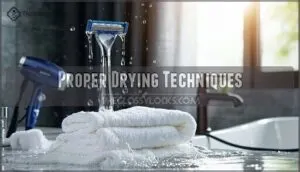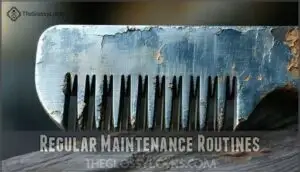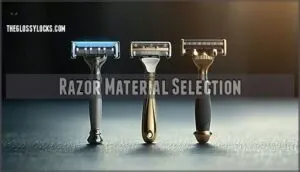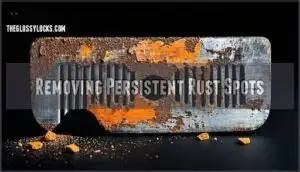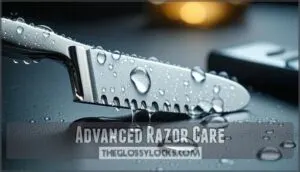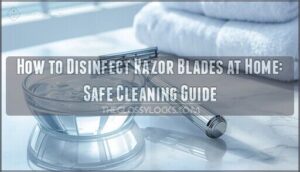This site is supported by our readers. We may earn a commission, at no cost to you, if you purchase through links.
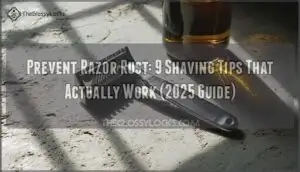
Pat it dry with a towel—don’t just shake off the water. Store your razor in a dry spot, away from humid areas like the shower.
If you want extra protection, apply a thin layer of mineral oil or baby oil to the blade. Avoid leaving your razor in standing water, as that’s a fast track to rust.
Choosing stainless steel razors can also help since they’re more rust-resistant. With a little care, your razor will last longer and stay sharper.
Table Of Contents
- Key Takeaways
- Razor Rust Causes
- Rust Prevention Methods
- Razor Material Selection
- Cleaning and Maintenance
- Advanced Razor Care
- Frequently Asked Questions (FAQs)
- How do you keep a razor from rusting?
- Why do razor blades rust after a shave?
- How do you rust a razor blade?
- Do razor blades rust?
- How do you clean a rusty safety razor?
- What happens if you leave rust on your razor?
- How often should I clean my razor to prevent rust?
- Can I prevent razor rust by storing it in a certain way?
- What can I do if my razor already has rust spots?
- How to prevent shaving razor from rusting?
- Conclusion
Key Takeaways
- Dry your razor completely after every use – Rinse thoroughly to remove soap and debris, then pat dry with a towel instead of just shaking off water, since moisture and oxygen are the main culprits behind rust formation.
- Store your razor in a dry location away from humidity – Keep it outside the bathroom in a drawer or use a razor stand that allows air circulation, avoiding humid areas where moisture can linger and accelerate corrosion.
- Apply a protective oil coating for extra rust prevention – Use mineral oil, baby oil, or specialized blade oils to create a barrier against moisture and oxygen, reapplying weekly or after each use, depending on your environment’s humidity.
- Choose stainless steel razors with high chromium content – Opt for materials like 316L stainless steel that contain 16-18% chromium for superior rust resistance, avoiding high-carbon steel options that oxidize quickly when exposed to moisture.
Razor Rust Causes
Rust forms on your razor when moisture and oxygen meet the metal, weakening it over time.
Moisture and oxygen team up to create rust, silently weakening your razor and shortening its lifespan.
Dead skin, hair, and leftover shaving cream can trap water, creating the perfect environment for rust to develop quickly.
Moisture and Oxygen Exposure
Moisture and oxygen are the prime enemies of your razor. When water lingers, oxidation kicks in, triggering rust formation. The trapped moisture from shaving, combined with humidity, accelerates material degradation over time.
- Rinse and dry your razor after every use.
- Store it outside the bathroom.
- Avoid leaving it in standing water.
- Use a razor stand for air circulation.
- Reduce shower humidity with ventilation to prevent material degradation.
High-Carbon Steel Oxidation
High-carbon steel rusts quickly because it’s more reactive to oxidation mechanisms.
When water lingers, oxidation weakens the steel composition, leading to blade deterioration.
To prevent razor rust, dry your blade thoroughly and store it in a dry spot.
Use this quick guide:
| Rust Factor | Impact | Solution |
|---|---|---|
| Water Exposure | Oxidation starts | Dry thoroughly |
| Blade Composition | Rust accelerants | High-chromium steel |
| Prolonged Use | Faster deterioration | Regular maintenance |
The key to preventing rust is to understand the factors that contribute to it, including water exposure and blade composition, and to take preventative measures such as regular maintenance.
Dead Skin Cells and Hair Contribution
Dead skin cells and hair trapped between razor blades aren’t just gross—they speed up rust.
Dead skin and hair buildup isn’t just unsightly—it accelerates rust, dulls blades, and leads to irritating, uneven shaves.
This residue buildup promotes bacterial growth and blade clogging, leading to skin irritation and dull edges.
Regular cleaning frequency matters.
Rinse thoroughly after every use and check for hidden debris.
Effective razor cleaning methods are essential for razor rust prevention, ensuring a smoother shave every time.
Humidity and Water Effects
In steamy bathrooms, water and humidity work together to speed up razor rusting causes.
Bathroom humidity clings to blades, while water hardness leaves mineral deposits that encourage blade corrosion.
A poor storage environment worsens things, locking in moisture.
Razor rust prevention starts with drying techniques—pat blades dry and keep them air-exposed.
A dry blade lasts longer and shaves smoother.
Rust Prevention Methods
Keeping your razor rust-free doesn’t have to be a hassle if you follow a few simple steps.
By drying, storing, and maintaining it properly, you can extend its life and keep your shaves smooth.
Proper Drying Techniques
Drying your razor the right way makes a big difference for preventing rust.
Try these razor drying methods:
- Towel Drying: Gently pat the blade dry with a soft towel to remove water.
- Air Drying: Leave it upright in a well-ventilated spot.
- Blow Drying: Use a hair dryer for 10 seconds to guarantee complete dryness before storage.
Storage and Handling Tips
How do you keep razors rust-free? Start with proper razor storage.
After using blade drying methods, store razors in dry areas like drawers or shelves. Moisture control is key, so avoid leaving them near sinks.
DIY storage solutions, such as razor stands or plastic covers, help. Consider specialized razor holders for enhanced protection.
For travel, use protective cases. These simple storage solutions prevent rust effectively.
Protective Coatings and Oils
A thin layer of mineral oil or specialized blade oiling products can shield your razor from rust.
Oil coatings work by creating a barrier against moisture and oxygen, enhancing coating longevity. Choose oil types suited for your razor’s material compatibility.
Apply using a cloth or fingertips after thorough drying. It’s an affordable, effective method ensuring maximum razor lifespan.
Many users find success with specialized blade oils.
Regular Maintenance Routines
After applying protective coatings, stick with regular razor maintenance tips.
Rinse thoroughly after each shave and use effective drying methods, like patting with a clean towel. Adjust your cleaning frequency to remove residue buildup.
Inspect blades for rust or wear during routine shaving razor cleaning. Add oiling blades and occasional sharpening techniques to keep razor blade rust at bay.
Similarly, maintaining vibrant locks requires a color-safe washing routine.
Razor Material Selection
Choosing the right razor material can make a big difference in preventing rust. Focus on options like stainless steel or plated razors that resist corrosion and last longer.
Stainless Steel Grade Options
Choosing the right stainless steel grade for your razor blade makes rust prevention easier.
Consider these options:
- 316L Steel: High chromium content and molybdenum for excellent corrosion resistance.
- 303 Steel: Lower chromium, sulfur influence increases rust risk.
- Plated Materials: Zinc or nickel coatings add durability.
Choose wisely; the alloy composition affects blade life and rust resistance.
Regular application of shave oil prevents rust.
Chromium Content and Rust Resistance
Chromium content is key to rust resistance in stainless steel.
Higher levels, like in 316L stainless steel, create a stronger barrier against corrosion. Lower grades, such as 303, offer less protection.
| Grade | Rust Resistance | Chromium % | Durability |
|---|---|---|---|
| 316L | High | 16-18% | Superior |
| 304 | Moderate | 18% | Strong |
| 303 | Low | 17% | Weaker |
| 430 | Minimal | 16% | Basic |
Choose wisely to boost rust prevention!
Sulfur Content and Corrosion
Steel composition plays a big role in razor rusting causes, especially with sulfur’s impact on corrosion rate.
Higher sulfur levels weaken the protective layer on stainless steel, leading to faster material degradation.
Opt for a steel grade with low sulfur content for better rust prevention.
One effective method involves coating the metal with zinc, and pair this choice with proper shaving tips rust solutions to extend your razor’s life.
Plated Materials and Coatings
When picking razors, look for rust-resistant materials like nickel or chrome plating.
These protective coatings add corrosion resistance by blocking moisture and air. Coating thickness matters—thicker layers boost durability.
Material interactions, like pairing stainless steel with plating, enhance corrosion protection. Proper application methods guarantee long-lasting rust prevention.
For effective razor rust solutions, plated materials are a smart, low-maintenance choice.
Cleaning and Maintenance
Keeping your razor clean and dry is the easiest way to stop rust in its tracks.
A little effort after each shave can save you from dull blades and rusty surprises.
Rinsing and Drying Procedures
After selecting the right razor material, focus on razor blade care.
Use warm water for rinsing blades after each shave, removing soap residue and hair.
Drying blades is key—pat them gently with a clean towel or tissue, avoiding moisture traps.
For razor blade drying, skip air drying in humid bathrooms.
Proper rinsing frequency guarantees clean, rust-free blades.
Deep Cleaning Methods and Solutions
After rinsing and drying, it’s time for deeper razor blade cleaning.
Use rust removal solutions like vinegar soaking or baking soda for stubborn spots. For quick results, try rubbing alcohol sanitization or ultrasonic cleaners. A good option is finding an ultrasonic cleaner for this purpose.
- Vinegar soaking breaks down rust effectively.
- Baking soda paste scrubs away buildup.
- Ultrasonic cleaners reach tight areas effortlessly.
Finish with thorough drying to prevent re-rusting.
Sanitizing and Disinfecting Techniques
After deep cleaning, focus on razor hygiene with alcohol sanitization or UV disinfection to kill bacteria.
Rubbing alcohol disinfection is quick—just dip the blade for a few seconds. Boiling razors works too but avoid frequent use to prevent sharpening impact.
Chemical solutions designed for blade sanitizing are another option. Proper razor blade cleaning keeps your shave safe and effective.
Natural options like tea tree oil offer gentler disinfection, and you can find more information on Natural options to enhance your razor care routine with effective methods.
Removing Persistent Rust Spots
Got stubborn rust spots on your razor? Here’s how to tackle them:
- Use sanding techniques with fine-grit sandpaper to smooth rusty areas.
- Try a chemical rust removal solution like vinegar or baking soda paste.
- Opt for the electrolysis method for heavy rust buildup.
- Seek professional restoration for antique or high-value razors.
Always dry thoroughly to prevent re-rusting!
Advanced Razor Care
Taking care of your razor goes beyond basic cleaning if you want it to last.
Advanced razor care guarantees your blade stays sharp, rust-free, and ready for a smooth shave every time.
Travel and Storage Considerations
When you’re on the move, pack your razor in travel cases that allow airflow to prevent trapped moisture.
For drying on-the-go, pat the razor dry with a towel and store it in a moisture-free spot.
Humidity control is key—avoid leaving it in damp hotel bathrooms.
Check TSA rules for travel-friendly razor options and follow airline regulations for safe packing.
Oil Application and Reapplication
After drying your razor, apply a thin oil coating to shield the blade from rust.
Olive oil, baby oil, or specialized razor blade oiling products work well. Use a clean rag to spread the oil evenly, ensuring no residue remains.
Reapply weekly or after each use, depending on humidity. Oil alternatives like mineral oil also offer great protection.
Razor Stand and Container Options
Razor stands and storage solutions keep blades dry and rust-free.
Stainless steel stands resist corrosion, while vertical designs improve airflow.
For travel, cases with container ventilation protect razors from moisture.
Magnetic holders offer handy DIY solutions for small spaces.
To further prevent corrosion, consider sterilizing with alcohol for extra protection.
Choose razor blade storage solutions that prevent water buildup, like stands with drainage features or compact, well-ventilated travel cases, to keep blades dry and in good condition with proper care.
DIY Storage and Maintenance Solutions
For easy razor care, try repurposed containers like mason jars or tins as creative stands.
Add homemade desiccants, like rice or silica gel, to absorb moisture. Use magnetic holders for convenient razor storage solutions.
For oiling alternatives, olive or baby oil works well. These shaving tips rust-proof your blades while keeping razor blade maintenance simple and effective.
Frequently Asked Questions (FAQs)
How do you keep a razor from rusting?
Keep your razor rust-free by drying it completely after each use, storing it in a dry, ventilated spot, and applying a light coat of mineral oil.
Avoid leaving it in humid bathrooms or wet areas.
Why do razor blades rust after a shave?
Around 85% of razor blades contain high-carbon steel, which rusts quickly when exposed to moisture.
After shaving, leftover water, soap, and humidity create a perfect storm for oxidation, dulling your blade and shortening its lifespan.
How do you rust a razor blade?
To rust a razor blade, leave it damp in a humid place, like a bathroom.
Moisture, combined with oxygen, triggers oxidation.
Trapping remnants of shaving cream or hair between blades speeds up the process.
Do razor blades rust?
Unfortunately, your trusty blade isn’t immune to time’s effects.
Yes, razor blades absolutely rust when exposed to moisture and oxygen.
High-carbon steel oxidizes quickly, especially in humid bathrooms where water lingers on metal surfaces, leading to rust.
How do you clean a rusty safety razor?
Soak your rusty safety razor in warm water mixed with white vinegar and baking soda for fifteen minutes.
Scrub gently with an old toothbrush, rinse thoroughly, then dry completely before applying protective oil.
What happens if you leave rust on your razor?
Leaving rust on your razor dulls the blade, making shaves less effective and increasing your risk of nicks and cuts.
You’ll also face potential skin irritation from bacteria buildup on the corroded surface.
How often should I clean my razor to prevent rust?
Daily maintenance beats neglecting your blade’s wellbeing.
You should rinse and dry your razor after every shave, then apply a light oil coating.
Weekly deep cleaning with soap removes stubborn buildup completely.
Can I prevent razor rust by storing it in a certain way?
Yes, store your razor in a dry location away from the bathroom’s humidity.
Use a razor stand for air circulation, apply protective oil coating, and keep it in a drawer or medicine cabinet instead.
What can I do if my razor already has rust spots?
Scrub rust spots gently with castile soap and an old toothbrush.
For stubborn rust, soak your razor in warm water mixed with white vinegar and baking soda, then wipe clean and dry thoroughly.
How to prevent shaving razor from rusting?
Your razor’s worst enemy isn’t your beard—it’s moisture lurking around like an unwelcome houseguest.
Rinse thoroughly after shaving, dry completely with a towel, apply light oil coating, and store in a dry location away from humidity.
Conclusion
Remember the old saying that an ounce of prevention is worth a pound of cure? That wisdom rings especially true in the context of razor care.
These prevent razor rust shaving tips will keep your blades sharp and your wallet happy. Simple steps like proper drying, smart storage, and regular maintenance make all the difference.
You don’t need expensive products or complicated routines. Just consistent care and attention to detail will extend your razor’s life substantially, which is worth a pound of cure.
- https://carbonshavingco.com/blogs/resources-and-blog/machined-stainless-steel-safety-razor-grades-and-titanium
- https://www.unifiedalloys.com/blog/304-316-stainless
- https://www.alleima.com/en/news-media/technical_articles_blogs/2023/09/why-martensitic-stainless-steels-are-the-cutting-edge-of-razor-blade-metal
- https://www.reddit.com/r/wicked_edge/comments/4nhtmi/stainless_steel_vs_rust_in_razors
- http://dixonvalve.com/en/news-and-events/news/guide-stainless-steel-families-and-grades

